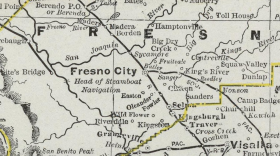The foothills of the Southern Sierra missed out on most of the action in the first years of the California Gold Rush. But all that changed in the mountains of Kern County in 1851. Today on KVPR’s Central Valley Roots, the story of the Kern River gold rush.
Four years after John Marshall discovered gold at Sutter’s Mill, a member of John C. Fremont’s expedition discovered gold in Greenhorn Gulch in the Greenhorn Mountains northeast of Bakersfield.
Soon prospectors made other gold discoveries near the Kern River, setting off a localized gold rush. Almost overnight, new communities popped up to serve the miners. Towns like Whiskey Flat, also known as Old Kernville, Petersburg, Glennville, and Keyesville, emerged as rough-and-tumble mining towns. One of the most prominent was Havilah and in 1866, it became the county seat of the newly formed Kern County. It would hold that title until 1874 when the seat of county government moved to Bakersfield.
Before 1855 most of the gold activity in the Kern River area was placer mining – think miners panning for gold in streams. After 1855, the miners shifted to lode mining, also known as hard rock mining. In addition to the mines near the Kern River, significant gold extraction also took place in the Kern County desert, both near Mojave and Rangsburg, home of the famous Yellow Aster Mine.
In all Kern County has produced more gold than another other county in California south of the Mother Lode region.






